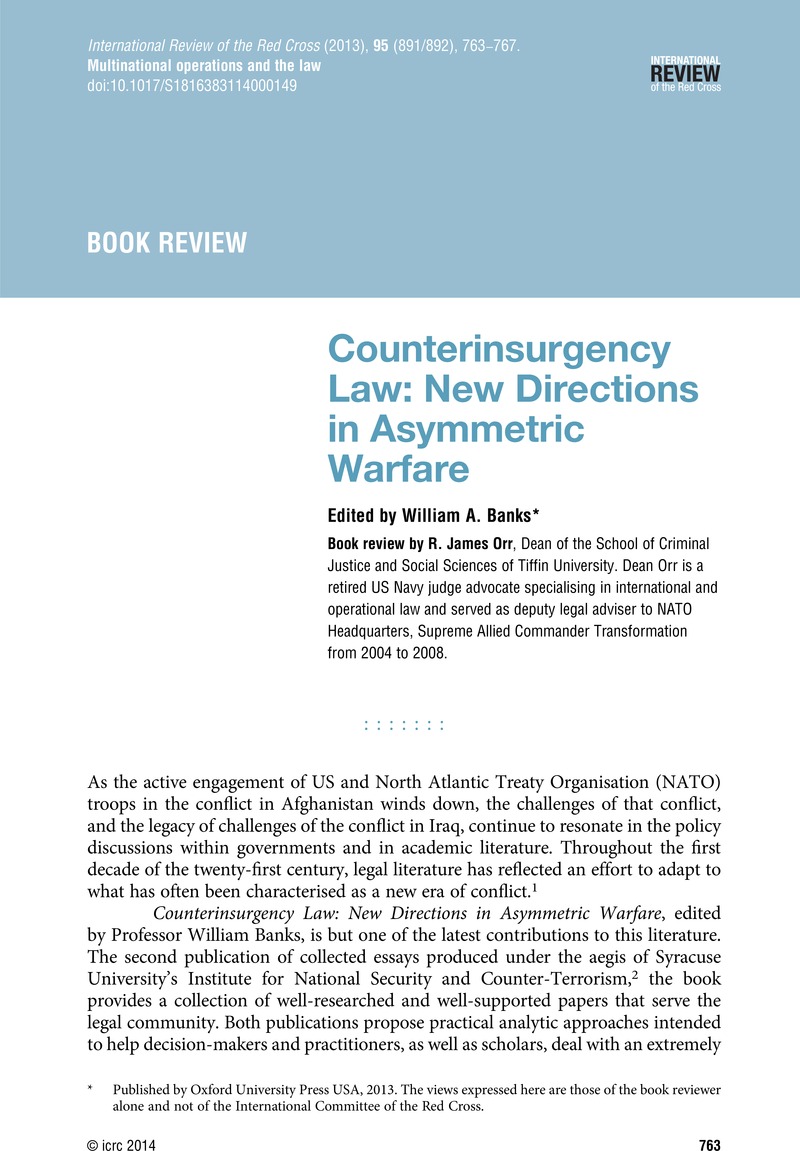No CrossRef data available.
Published online by Cambridge University Press: 06 June 2014

1 Many books and articles on the subject exist. See, for example, Schmitt, Michael N. and Pejic, Jelena, International Law and Armed Conflict: Exploring the Faultlines – Essays in Honour of Joram Dinstein, Martinus Nijhoff Publishers, Leiden, 2007CrossRefGoogle Scholar; Lewis, Michael W., The War on Terror and the Laws of War, Oxford University Press, Oxford, 2009Google Scholar; Bayley, David H. and Perito, Robert M., The Police in War: Fighting Insurgency, Terrorism, and Violent Crime, Lynne Rienner, Boulder, CO, 2010CrossRefGoogle Scholar.
2 The first of the series was New Battlefields/Old Laws: Critical Debates on Asymmetric Warfare, also edited by William A. Banks and published by Columbia University Press in 2011 as part of the Columbia Studies in Terrorism and Irregular Warfare series.
3 See, for example Gian Gentile, ‘A strategy of tactics: population-centric COIN and the Army’, in Parameters, Autumn 2009, pp. 5–17, available at: http://strategicstudiesinstitute.army.mil/pubs/parameters/Articles/09autumn/gentile.pdf (last visited 12 January 2014); Gentile, Gian, ‘Wrong Turn; America's Deadly Embrace of Counterinsurgency’, in The New Press, New York, 2013Google Scholar; and Edward Luttwak, ‘Dead end: counterinsurgency warfare as military malpractice’, in Harper's Magazine, February 2009, available at: www.ifri.org/files/politique_etrangere/luttwak.pdf (last visited 29 January 2014).
4 Banks, William A., Counterinsurgency Law: New Directions in Asymmetric Warfare, Oxford University Press USA, New York, 2013, pp. xiii–xvGoogle Scholar.
5 Sitaraman, Ganesh, The Counterinsurgent's Constitution: Law in the Age of Small Wars, Oxford University Press USA, New York, 2013Google Scholar.
6 W. A. Banks, above note 4, p. xii.
7 Melzer, Nils, Interpretive Guidance on the Notion of Direct Participation in Hostilities under International Humanitarian Law, International Committee of the Red Cross, 2009Google Scholar.
8 Part I focuses on framing the issue of convergence between the two bodies of law in COIN. Part II explains the issue of ‘Reunifying the laws of armed conflict: non-international conflict and COIN operations’. Part III addresses the specific challenges of protecting civilians and the accompanying increased risk to the military forces involved, while Part IV expands the discussion from COIN to other unconventional battlefields – terrorism, the use of drones, and maritime blockades.
9 The terms ‘irregular warfare’ and ‘unconventional warfare’ are often used interchangeably. In the United States, ‘irregular warfare’ is defined as ‘A violent struggle among state and non-state actors for legitimacy and influence over the relevant population(s)’, while ‘unconventional warfare’ is defined as ‘Activities conducted to enable a resistance movement or insurgency to coerce, disrupt, or overthrow a government or occupying power by operating through or with an underground, auxiliary, and guerrilla force in a denied area.’ United States Department of Defense, Department of Defense Dictionary of Military and Associated Terms, Joint Publication 1-02 of 8 November 2010 (as amended through 15 March 2014), pp. 136, 273, available at: www.dtic.mil/doctrine/new_pubs/jp1_02.pdf (last visited 9 April 2014).
10 W. A. Banks, above note 4, pp. 16–18.
11 Ibid., p. 30.
12 The nature of the changing operational landscape is illustrated by the discussion by former commandant of the US Marine Corps, General Charles Krulak, in his article ‘The strategic corporal: leadership in the three block war’, in Marines Magazine, January 1999, available at: www.au.af.mil/au/awc/awcgate/usmc/strategic_corporal.htm (last visited 1 December 2013).
13 W. A. Banks, above note 4, pp. 46 and 58.
14 Ibid., p. 87.
15 Ibid., pp. 89–90.
16 Ibid., p. 141.
17 Ibid., p. 161.
18 Ibid., p. 178.